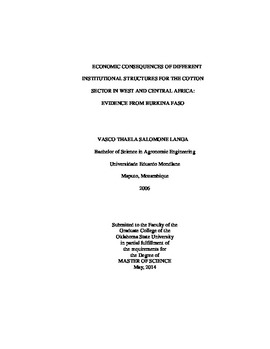| dc.contributor.advisor | Vitale, Jeffrey | |
| dc.contributor.author | Langa, Vasco Thaela Salomone | |
| dc.date.accessioned | 2015-06-17T20:06:41Z | |
| dc.date.available | 2015-06-17T20:06:41Z | |
| dc.date.issued | 2014-05-01 | |
| dc.identifier.uri | https://hdl.handle.net/11244/14956 | |
| dc.description.abstract | In West and Central African countries parastatal vertical coordination is used to control both the input and output markets. The decline of cotton yields and subsequent decline of the parastatals' performance in the late 1990s called for reforms. This thesis assesses the potential economic effects of different institutional structures for the parastatals in West and Central Africa, using the characteristics of the cotton sector in Burkina Faso. The thesis is based in the concept of economic surplus. A structural system is developed to measure the potential economic outcomes of three market alternatives to parastatal vertical coordination. Results demonstrate that when a parastatal is allowed to exercise market power, it extracts rents from the farmers maximizing the parastatal's economic surplus. The primary beneficiaries of the privatization of the cotton sector in West and Central African countries are the farmers, as a result of the higher price received in the output market. The parastatal extracts more from the output market than from the input market. With partial privatization farmers are better off when they receive the competitive cotton price, even when the parastatal exercises monopoly control of the input market, extracting rents from the farmers, than they are when the parastatal exercises monopsony in the output market (cotton buying) and farmers procure inputs in the competitive market. | |
| dc.format | application/pdf | |
| dc.language | en_US | |
| dc.publisher | Oklahoma State University | |
| dc.rights | Copyright is held by the author who has granted the Oklahoma State University Library the non-exclusive right to share this material in its institutional repository. Contact Digital Library Services at lib-dls@okstate.edu or 405-744-9161 for the permission policy on the use, reproduction or distribution of this material. | |
| dc.title | Economic Consequences of Different Institutional Structures for the Cotton Sector in West and Central Africa: Evidence from Burkina Faso | |
| dc.type | text | |
| dc.contributor.committeeMember | Adam, Brian D. | |
| dc.contributor.committeeMember | Epplin, Francis | |
| osu.filename | Langa_okstate_0664M_13405.pdf | |
| osu.accesstype | Open Access | |
| dc.description.department | Agricultural Economics | |
| dc.type.genre | Thesis | |
| dc.subject.keywords | cotton | |
| dc.subject.keywords | parastatal | |
| dc.subject.keywords | west africa | |
